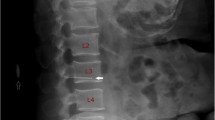Abstract
The purpose of this study was to identify the patient position for lumbar puncture associated with the widest interspinous distance utilizing ultrasound. Sixteen healthy adult volunteers were placed in three positions commonly used for lumbar puncture (lateral recumbent with knees to chest, sitting and bent forward over an adjustable bedside stand, and sitting with feet supported and chest to knees) and the distance between lumbar spinous processes was measured by ultrasound. Measurements were compared between the three positions. Differences were analyzed using Tukey’s honestly significant difference test. The results showed that the interspinous distance was significantly greater in the “sitting, feet supported” position than in the other two positions (P<0.001). The “sitting, feet supported” position may offer advantages for selected patients undergoing lumbar puncture. Ultrasonography may be a useful adjunct when performing lumbar puncture in the emergency department.




Similar content being viewed by others
References
Kooiker JC (1998) Spinal puncture and cerebrospinal fluid examination. In: Roberts JR, Hedges JR (eds) Clinical procedures in emergency medicine. Saunders, Philadelphia, pp 1054–1077
Sternbach G (1985) Lumbar puncture. J Emerg Med 2:199–203
Legg SJ, Gibbs V (1984) Measurement of the lumbar spinal canal by echo ultrasound. Spine 9:79–82
Kamei K, Hanai K, Matsui N (1990) Ultrasonic level diagnosis of lumbar disc herniation. Spine 15:1170–1174
Tervonen O, Lahde S, Vanharanta H (1991) Ultrasound diagnosis of lumbar disc degeneration. Comparison with computed tomography/discography. Spine 16:951–954
Ferguson J, Brin M, Goldman R, et al (1998) Review of the literature on spinal ultrasound for the evaluation of back pain and radicular disorders: Report of the Threrapeutics and Technology Assessment subcommittee of the American Academy of Neurology. Neurology 51:343–344
Cork RC, Kryc JJ, Vaughan RW (1980) Ultrasonic localization of the lumbar space. Anesthesiology 52:513–516
Currie JM (1984) Measurement of the depth to the extradural space using ultrasound. Br J Anesth 56:345–347
Ledsome JR, Lessoway V, Susak LE, Gagnon FA, Gagnon R, Wing PC (1996) Diurnal changes in lumbar intervertebral distance, measured using ultrasound. Spine 21:1671–1675
Wallace DH, Currie JM, Gilstrap LC, Santos R (1992) Indirect sonographic guidance for epidural anesthesia in obese pregnant patients. Reg Anesth 17:233–236
Acknowledgement
The authors are grateful to Polly Bijur, Ph.D., and Thomas Wendel, M.D., for their help with statistical analysis and for their insightful comments during the preparation of this manuscript.
Author information
Authors and Affiliations
Corresponding author
Rights and permissions
About this article
Cite this article
Sandoval, M., Shestak, W., Stürmann, K. et al. Optimal patient position for lumbar puncture, measured by ultrasonography. Emergency Radiology 10, 179–181 (2004). https://doi.org/10.1007/s10140-003-0286-3
Received:
Accepted:
Published:
Issue Date:
DOI: https://doi.org/10.1007/s10140-003-0286-3




